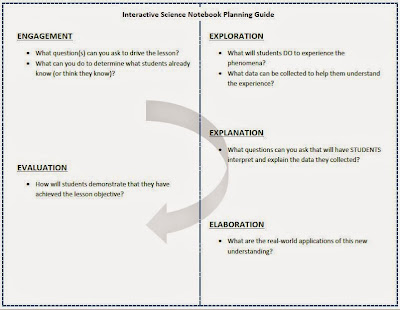After conducting professional development for about 2000 teachers, I realized I needed to adopt a hybrid model to bring the other 5000 over to "light side". There will always be a place for authentic ISNs in classroom, but I have to wean everyone off of worksheets first (#Death2Worksheets). Thus the model I have adopted brings in the best of both worlds.
It has the structure of traditional ISNs but built with efficiency in mind. Traditional ISNs utilize some classroom time to building the ISN including paste-ins, foldables, and data tables. These are all valuable tasks, but when there is only 30 minutes of instructional time (K-2 in my world), I want to make every minute focused on collecting and anything the data rather than making the data chart.
To the purest out there that are now scowling, I know what you're saying. Learning how to build a data table is an instructional tasks. Yes it is, but in NGSS the words "with guidance" appear quite a bit it the K-2 practices. As we move to grades 3-5, the pages will get more open-ended. Now, back to the show.
There a couple of ways to sum up our model. It still uses the left-right format, but when I first tried telling teachers that the output was on the left more than a few screams were heard. So after some consultation with my friends in the 6-12 world (middle and high schools have used ISNs for many moons in my district), a rephrasing of the model was developed.
On the left side, the student is talking to the teacher. On the right side the teacher is talking to the student. Another way to look at this is through the lens of the 5E model.
At the start of the lesson, students are asked to demonstrate what they know (or think they know).
During the lesson, students engage in understanding some phenomena. This encompasses Exploration and Explanation. Towards the end, students demonstrate their new understanding through a summative evaluation. I sometimes have a hard time separating the elaboration from the evaluation because in many cases, they both require students to apply what they know. For those of you writing SLOs, the left page captures where a student started and how far they have grown by the end.
This is not THE way. Everyday, this model evolves a little as we build the ISNs to compliment the curriculum. Below, are a couple of the pages currently in production for the field test next year. I produce these using Publisher. Our printshop copies and distributes to the schools.
Lastly, as we move into grades 3-5, I am looking for a digital version to replace the paper based model for K-2. I am having a hard time finding an efficient way for students to put down their ideas. As always, please comment. Don't take my word for it. Question everything.




I remind my middle school students that Mrs. Foote is always right, they get what's left. It gets a laugh but they remember the purpose for each side.
ReplyDeleteI like that!
ReplyDeleteThank you for sharing, Eric. I am wondering about the examples toward the bottom of the page. Am I assuming correctly these are examples of some of the paste-ins or foldables teachers would be having students add to an ISN? I like your point about "with-guidance" as that helps me come to terms with the purist side of me too :)
ReplyDeleteWe produce these locally using Microsoft Publisher. For each unit we produce a notebook and our printshop prints and sends them to the schools.
ReplyDeleteI'd love to hear more about going digital - it something we've been thinking about for a while. How do you keep the interactivity and sense of ownership and also make it digital? Using notability maybe? What are your thoughts?
ReplyDeleteI'm still working on this idea. Microsoft OneNote might be our option. I would not use it until at least grade 3. My concern with going digital is efficiency. I'm concerned students lose their thoughts between getting it from brain to computer. I am also worried about missing the sketching component. Yes, it is possible, but not quick.
Delete